November 2018

After Yama left, Sāvitrī returned to the place where her husband’s lifeless body lay. She placed his head on her lap once again and Satyavān slowly came back to life. His eyes were filled with deep love as he looked at Sāvitrī again and again, as though he had come back to her after a long voyage. As he looked at her, he said – “Seems like I have slept for too long. Why didn’t you wake me up? Where is that dark-skinned man who pulled me along...
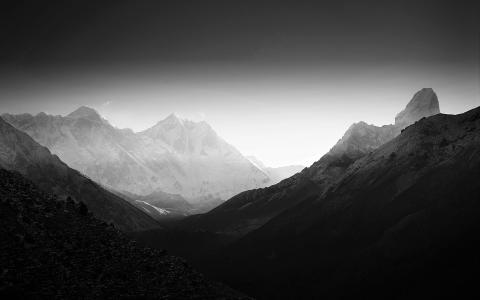
ಈಗ ಕಾಂಡಾನುಸಾರವಾಗಿ ಪರಿಶೀಲಿಸೋಣ:
ಬಾಲಕಾಂಡದಲ್ಲಿ ಮನಮುಟ್ಟುವ ಉಪಮೆಗಳೇ ವಿರಳ. ಅಷ್ಟೇಕೆ, ಉಳಿದ ಅಲಂಕಾರಗಳೂ ಕಡಮೆ. ಆದರೂ ಪ್ರಾತಿನಿಧಿಕವಾಗಿ ಅತ್ಯುತ್ತಮವೆನ್ನಬಹುದಾದ ಒಂದು ಉದಾಹರಣೆಯನ್ನು ಕಾಣಬಹುದು:
ಅಕರ್ದಮಮಿದಂ ತೀರ್ಥಂ ಭರದ್ವಾಜ ನಿಶಾಮಯ |
ರಮಣೀಯಂ ಪ್ರಸನ್ನಾಂಬು ಸನ್ಮನುಷ್ಯಮನೋ ಯಥಾ || (೧.೨.೫)
ಇಲ್ಲಿ ಆದಿಕವಿಗಳು ತಮ್ಮ ಶಿಷ್ಯ ಭರದ್ವಾಜನಿಗೆ ತಮಸಾನದಿಯ ತಿಳಿನೀರನ್ನು ಪರಿಚಯಿಸುತ್ತಾರೆ. ನಿರ್ಮಲವಾದ ನದೀಜಲವು ಸಜ್ಜನರ ಮನಸ್ಸಿನಂತೆ ಕಾಣುತ್ತದೆಂದು ಹೇಳುವ ಕವಿಯ ಪ್ರತಿಭೆ ನಿಜಕ್ಕೂ ಅಸಾಧಾರಣ. ಮೂರ್ತವನ್ನು ಅಮೂರ್ತಕ್ಕೆ ಹೋಲಿಸುವ ಪರಿ...
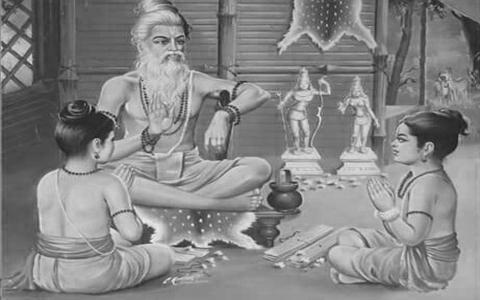
The Right Age for Conducting Upanayana[1]
There are several varying rules and prescriptions about the age of the boy who is to undergo the upanayana (the boy is referred to as the ‘vaṭu’). What is interesting to note is that the age was counted from conception.[2] From the earliest times we see in ancient India the notion that the age of a child must be counted.
It is prescribed for a brāhmaṇa boy to have his upanayana at age 8 (and not later...
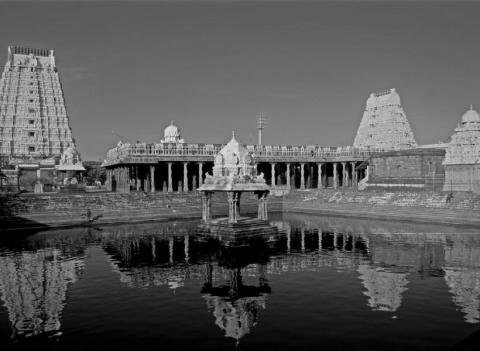
1.Śiva’s form as Naṭarāja
We know from the first chapter of the Nāṭyaśāstra (verses 41-45) that according to tradition, Śiva’s cosmic dance inspired Bharata to add the kaiṣikī-vṛtti to classical dance and to include aṅgahāra. (An aṅgahāra is series of karaṇa-s and cāri-s, and are like sentences in a prose text; cāri-s are movements of the body below the waist). Śiva is portrayed in his form as a cosmic dancer and as ‘Naṭarāja’ (‘the king of...
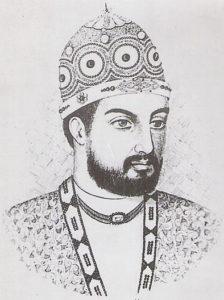
Ala-ud-din Khalji raided Chittorgarh and took its king Raja Ratan Singh as his prisoner. Rani Padmini was the wife of this same Raja Ratan Singh. Khalji pretended to befriend Ratan Singh, took his hospitality, and while exiting from Chittorgarh, took him prisoner by stealth and deceit. He sent this shameless message to Rani Padmini: “If you want to see your husband free, you must submit yourself to me.” Unfazed, Rani Padmini assembled five...
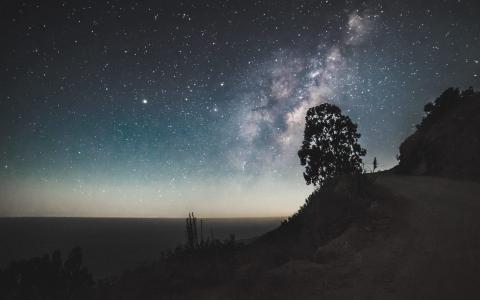
Ayurveda, being a medical science, does not consider cosmology as one of its central preoccupations. Vagbhata’s Ashtanga-Hrdayam, which contains the definitive summary of classical Ayurveda, makes not even a passing reference to cosmological theories.
Elaborate references to these theories, based mostly upon the Sankhya system, may however be found in the texts of Charaka and Sushruta. These theories owe their presence in these texts to two...

Final Days
I had visited Vasudevaiah’s home about a month before the day of his demise. He sat up in his bed, made space for me, and insisted that I sit right beside him. He was past ninety by then. Clean from tip to toe, it seemed like he had freshened up just then. His skin was of a golden brown colour; it turned pure gold whenever his mind got excited. Not a slightest sign of clutter was seen either on his body or his clothing. He was an...

The couple gathered fruits and put them together in a bundle. As Satyavān was working on the logs, his body began sweating all over. He had a tremendous headache. He immediately stopped his work, went to Sāvitrī, and said, “Sāvitrī! My limbs, head, and the entire body is aching. There is some pain in my chest too. I feels like a spear has pierced my head. I don’t seem to be keeping well. I'm not able to stand on my feet and feel like lying down...
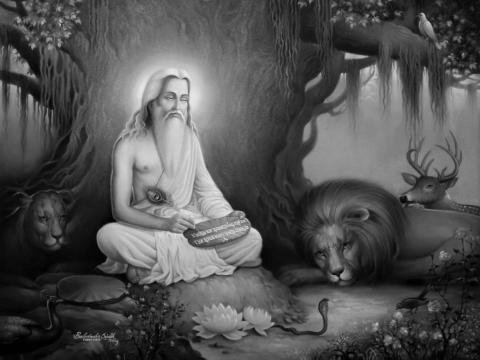
ವಿವಿಧಘನಾಲಂಕಾರಂ ವಿಚಿತ್ರವರ್ಣಾವಲೀಮಯಸ್ಫುರಣಮ್ |
ಶಕ್ರಾಯುಧಮಿವ ವಕ್ರಂ ವಲ್ಮೀಕಭುವಂ ಕವಿಂ ನೌಮಿ ||
(ಆರ್ಯಾಸಪ್ತಶತೀ, ೧.೩೦)
೧
ಭಗವಾನ್ ವಾಲ್ಮೀಕಿಮಹರ್ಷಿಗಳ ಆದಿಕಾವ್ಯ ರಾಮಾಯಣವು ಕಾಳಿದಾಸನ ಮಾತಿನಲ್ಲಿ “ಕವಿಪ್ರಥಮಪದ್ಧತಿ” – ಕವಿಗಳ ಪಾಲಿಗೆ ಮೊದಲ ಹೆದ್ದಾರಿ. ಇದು ಬಹ್ವರ್ಥಗ್ರಾಸಿಯಾದ ಯಥಾರ್ಥವರ್ಣನೆ. ರಾಮಾಯಣವು ರಸಿಕರಂಜನೆಯಾಗಿ ಮಾತ್ರವಲ್ಲದೆ ಕವಿ-ಕಲಾವಿದರ ಪಾಲಿಗೂ ನಿರಂಜನಪ್ರೇರಕಸಾಮಗ್ರಿಯಾಗಿ ರಾಜಿಸಿದೆ. ಹೀಗೆ ಭಾವಯಿತ್ರೀ ಮತ್ತು ಕಾರಯಿತ್ರೀ ಪ್ರತಿಭೆಗಳೆರಡಕ್ಕೂ ವಾಲ್ಮೀಕಿಮುನಿಗಳ ಒತ್ತಾಸೆ ಮಿಗಿಲಾಗಿದೆ. ಪ್ರಸ್ತುತಲೇಖನವು ಕವಿಗಳ ಪಾಲಿಗೆ...
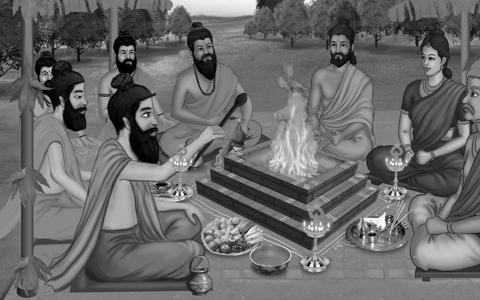
Most of our ancient thinkers were of the opinion that only the male members of the brāhmaṇa, kṣatriya, and vaiśya varṇas were eligible to study the Vedas.[1] And since the upanayana saṃskāra was primarily meant as an entry to the study of the Vedas, it was not applicable to women of all varṇas and to śūdras.[2]
There are, however, exceptions to this rule. For instance, one of the ancient teachers, Ācārya Bādarī mentions[3] that everyone,...
